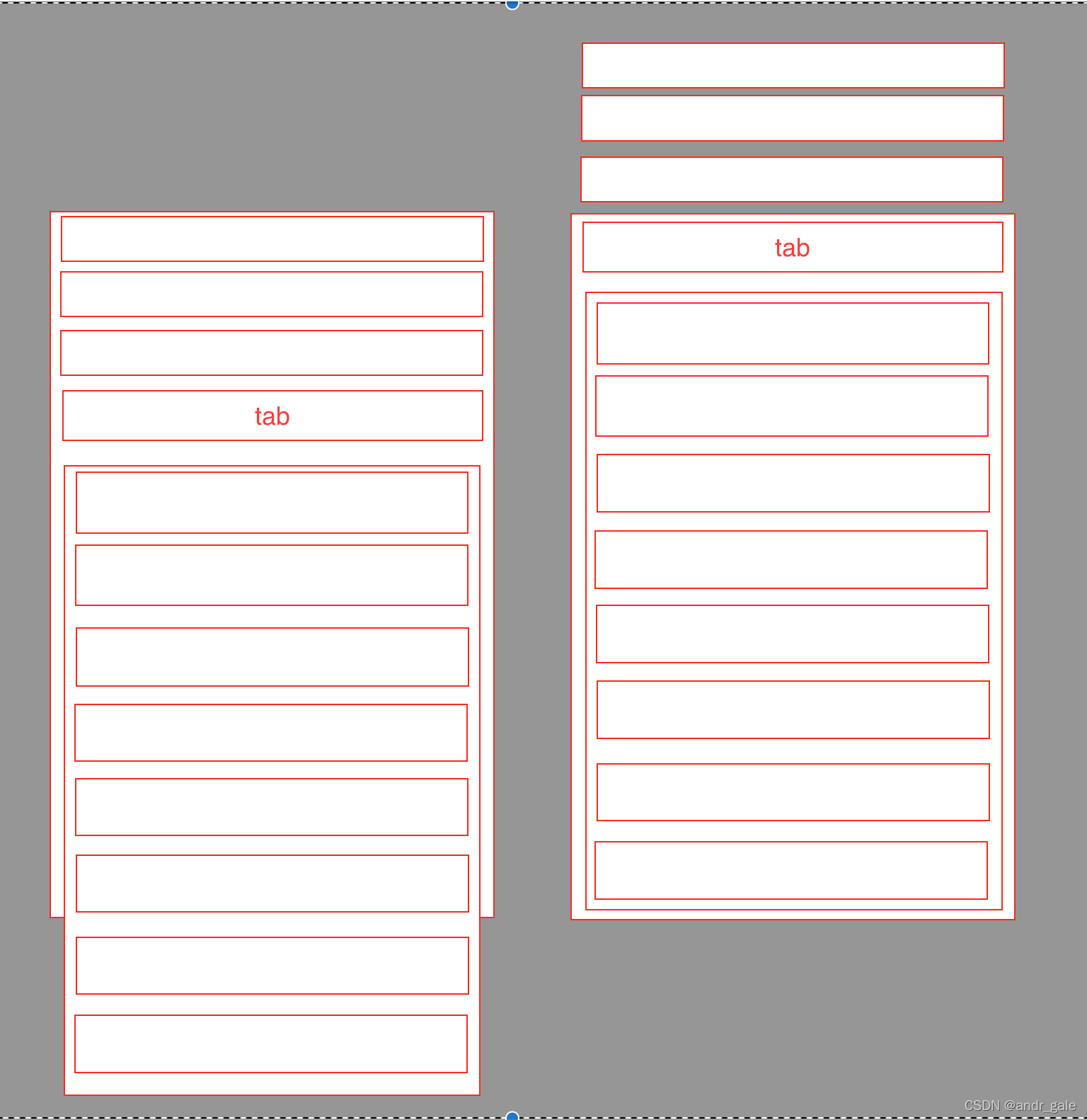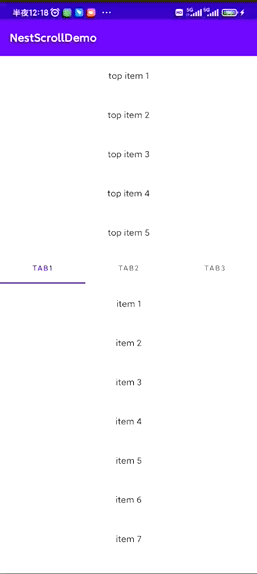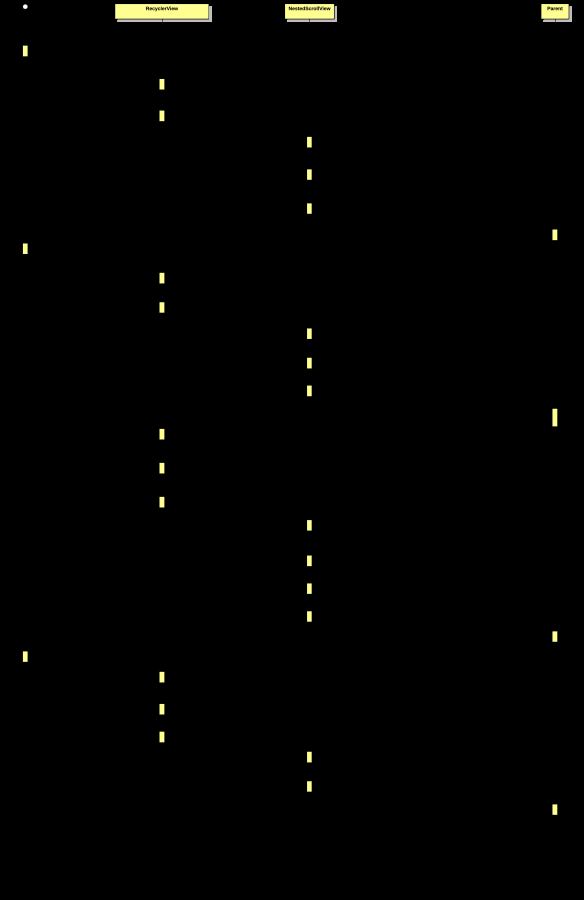NestScrollView嵌套RecyclerView
andr_gale 人气:0一.概述
本文主要实现淘宝首页嵌套滑动,中间tab吸顶效果,以及介绍NestScrollView嵌套RecyclerView处理滑动冲突的方法,淘宝首页的效果图如下:

二.开搞
首先我们通过一张图来分析下页面的布局结构:

先把最基础的页面搭出来,禁用Recycler滑动只需要重写onInterceptTouchEvent、onTouchEvent返回值都设为false即可:
<?xml version="1.0" encoding="utf-8"?>
<ScrollView xmlns:android="http://schemas.android.com/apk/res/android"
xmlns:app="http://schemas.android.com/apk/res-auto"
xmlns:tools="http://schemas.android.com/tools"
android:layout_width="match_parent"
android:layout_height="match_parent"
tools:context=".activiy.ViewPagerActivity"
android:background="#f2f2f2">
<LinearLayout
android:layout_width="match_parent"
android:layout_height="match_parent"
android:orientation="vertical">
<com.aykj.nestscrolldemo.widget.NoScrollRecyclerView
android:id="@+id/top_recycler_view"
android:layout_width="match_parent"
android:layout_height="wrap_content"/>
<LinearLayout
android:layout_width="match_parent"
android:layout_height="match_parent"
android:orientation="vertical">
<View
android:layout_width="match_parent"
android:layout_height="1px"
android:background="#e0e0e0"/>
<com.google.android.material.tabs.TabLayout
android:id="@+id/tab_view"
android:layout_width="match_parent"
android:layout_height="wrap_content" />
<View
android:layout_width="match_parent"
android:layout_height="1px"
android:background="#e0e0e0"/>
<androidx.viewpager.widget.ViewPager
android:id="@+id/view_pager"
android:layout_width="match_parent"
android:layout_height="match_parent"/>
</LinearLayout>
</LinearLayout>
</ScrollView>
public class ViewPagerActivity extends AppCompatActivity {
private List<String> topDatas = new ArrayList<>();
private List<String> tabTitles = new ArrayList<>();
ActivityViewPagerBinding viewBinding;
private RecyclerAdapter topAdapter;
private DividerItemDecoration divider;
private TabFragmentAdapter pagerAdapter;
@Override
protected void onCreate(Bundle savedInstanceState) {
super.onCreate(savedInstanceState);
viewBinding = ActivityViewPagerBinding.inflate(LayoutInflater.from(this));
setContentView(viewBinding.getRoot());
initDatas();
initView();
}
private void initDatas() {
topDatas.clear();
for(int i=0; i<5; i++) {
topDatas.add("top item " + (i + 1));
}
tabTitles.clear();
tabTitles.add("tab1");
tabTitles.add("tab2");
tabTitles.add("tab3");
}
private void initView() {
//init topRecycler
divider = new DividerItemDecoration(this, LinearLayout.VERTICAL);
divider.setDrawable(new ColorDrawable(Color.parseColor("#ffe0e0e0")));
viewBinding.topRecyclerView.setLayoutManager(new LinearLayoutManager(this));
viewBinding.topRecyclerView.addItemDecoration(divider);
topAdapter = new RecyclerAdapter(this, topDatas);
viewBinding.topRecyclerView.setAdapter(topAdapter);
//initTabs with ViewPager
pagerAdapter = new TabFragmentAdapter(getSupportFragmentManager(), tabTitles);
viewBinding.viewPager.setAdapter(pagerAdapter);
viewBinding.tabView.setupWithViewPager(viewBinding.viewPager);
viewBinding.tabView.setTabMode(TabLayout.MODE_FIXED);
}
}

可以看到ViewPager没有正常显示出来,这个时候可以重写ViewPager的onMeasure,重新测量ViewPager的宽高。也可以换用ViewPager2
public class CustomViewPager extends ViewPager {
...
@Override
protected void onMeasure(int widthMeasureSpec, int heightMeasureSpec) {
//重写ViewPager的onMeasure
int width = 0;
int height = 0;
for(int i=0; i<getChildCount(); i++) {
View childView = getChildAt(0);
measureChild(childView, widthMeasureSpec, heightMeasureSpec);
width = Math.max(width, childView.getMeasuredWidth());
height = Math.max(height, childView.getMeasuredHeight());
}
height += getPaddingTop() + getPaddingBottom();
heightMeasureSpec = MeasureSpec.makeMeasureSpec(height, MeasureSpec.EXACTLY);
super.onMeasure(widthMeasureSpec, heightMeasureSpec);
}
}

从上面的效果图可以看到,ViewPager能正常显示出来了,但是在RecyclerView上滑动的时候发现,RecyclerView滑动完了之后,ScrollView才会滑动,并且ScrollView只滑动了一小段距离,这是因为首先ScrollView是不支持嵌套滑动的
ScrollView内部的第一个子View中所有子View的高度 = 顶部的RecyclerView高度 + TabLayout高度 + 底部RecyclerView中所有可见Item的高度
这个高度只比ScrollView的高度大一点点导致的。为了实现嵌套滑动需要使用NestedScrollView,接下来把ScrollView替换成NestedScrollView:

整个页面可以滑完,看起来就像是两个Scroll被合并成一个了,如果单单只是实现上面的界面效果,我们完全可以使用一个RecyclerView即可,但是Tab没有吸顶,这是因为:
ScrollView内部的第一个子View中所有子View的高度 = 顶部的RecyclerView高度 + TabLayout高度 + 底部RecyclerView中所有Item的高度
要实现Tab吸顶,只需要重写NestedScrollView的onMeasue方法,将TabLayout的高度和ViewPager的高度之和设置为NestedScrollView的高度:

public class StickyScrollLayout extends NestedScrollView {
@Override
protected void onFinishInflate() {
super.onFinishInflate();
int count = getChildCount();
if(count == 1) {
View firstChild = getChildAt(0);
if(firstChild != null && firstChild instanceof ViewGroup) {
int childCount = ((ViewGroup) firstChild).getChildCount();
if(childCount > 1) {
topView = ((ViewGroup) firstChild).getChildAt(0);
contentView = ((ViewGroup) firstChild).getChildAt(1);
}
}
}
}
@Override
protected void onMeasure(int widthMeasureSpec, int heightMeasureSpec) {
super.onMeasure(widthMeasureSpec, heightMeasureSpec);
if(contentView != null) {
ViewGroup.LayoutParams contentLayoutParams = contentView.getLayoutParams();
contentLayoutParams.height = getMeasuredHeight();
contentView.setLayoutParams(contentLayoutParams);
}
}
}

此时TabLayout可以吸顶了
三.处理嵌套滑动
从上图中可以看出,当我们在RecyclerView上向上滑动时,需要等RecyclerView滑动完,外部的NestedScrollView才开始滑动,而我们希望NestedScrollView中顶部的RecyclerView滑完之后,底部的RecyclerView才开始滑动,这是为什么呢?
查看NestedScrollView和RecyclerView的源码,可以知道NestedScrollView和RecyclerView分别实现了NestedScrollingParent3,NestedScrollingChild3接口,分别用来表示嵌套滑动的父View、嵌套滑动的子View,当我们的手指在RecyclerView上滑动时,滑动事件会从上往下分发至RecyclerView的onTouchEvent中,RecyclerView会依次响应ACTION_DOWN、ACTION_MOVE、ACTION_UP
RecyclerView在处理ACTION_DOWN时的关键代码如下:
public boolean onTouchEvent(MotionEvent e) {
switch (action) {
case MotionEvent.ACTION_DOWN: {
if (canScrollHorizontally) {
nestedScrollAxis |= ViewCompat.SCROLL_AXIS_HORIZONTAL;
}
if (canScrollVertically) {
nestedScrollAxis |= ViewCompat.SCROLL_AXIS_VERTICAL;
}
startNestedScroll(nestedScrollAxis, TYPE_TOUCH);
} break;
}
return true;
}
当手指按下屏幕时会调用其作为NestedScrollingChild的实现方法startNestedScroll,在startNestedScroll的具体实现中,会一级一级的往上查找是否有NestedScrollingParent,如果有,会调用NestedScrollingParent的onStartNestedScroll方法通知它我即将要开始滑动了,然后NestedScrollingParent会调用onNestedScrollAccepted继续传递给上层的NestedScrollingParent,此处的NestedScrollingParent整好由NestedScrollView来充当,而NestedScrollView的上层已经找不到NestedScrollingParent了,时间传给NestedScrollView之后就中断了。
紧接着处理一系列的ACTION_MOVE:
public boolean onTouchEvent(MotionEvent e) {
switch (action) {
case MotionEvent.ACTION_MOVE: {
if (dispatchNestedPreScroll(
canScrollHorizontally ? dx : 0,
canScrollVertically ? dy : 0,
mReusableIntPair, mScrollOffset, TYPE_TOUCH
)) {
dx -= mReusableIntPair[0];
dy -= mReusableIntPair[1];
// Updated the nested offsets
mNestedOffsets[0] += mScrollOffset[0];
mNestedOffsets[1] += mScrollOffset[1];
// Scroll has initiated, prevent parents from intercepting
getParent().requestDisallowInterceptTouchEvent(true);
}
if (scrollByInternal(
canScrollHorizontally ? dx : 0,
canScrollVertically ? dy : 0,
e)) {
getParent().requestDisallowInterceptTouchEvent(true);
}
} break;
}
return true;
}
RecyclerView接收到ACTION_MOVE后,首先会调用其作为NestedScrollingChild的实现方法dispatchNestedPreScroll,在dispatchNestedPreScroll的具体实现中,会一级一级的往上查找是否有NestedScrollingParent,如果有,会调用NestedScrollingParent的dispatchNestedPreScroll,紧接着调用NestedScrollView的onNestedPreScroll,来告诉NestedScrollView我即将要滑动 xxx 距离,你需不需要滑动,在NestedScrollView的onNestedPreScroll方法中并不会去响应滑动,又会把自己作为一个NestedScrollingChild,把事件继续往上传递,而在NestedScrollView的上层已经没有可以处理嵌套滑动的NestedScrollingParent了
@Override
public void onNestedPreScroll(@NonNull View target, int dx, int dy, @NonNull int[] consumed,
int type) {
dispatchNestedPreScroll(dx, dy, consumed, null, type);
}
具体的事件传递流程如下图:

因此我们可以重写NestedScrollView的onNestedPreScroll方法来使NestedScrollView滑动
public class StickyNestedScrollLayout extends NestedScrollView {
@Override
protected void onFinishInflate() {
super.onFinishInflate();
int count = getChildCount();
if(count == 1) {
View firstChild = getChildAt(0);
if(firstChild != null && firstChild instanceof ViewGroup) {
int childCount = ((ViewGroup) firstChild).getChildCount();
if(childCount > 1) {
topView = ((ViewGroup) firstChild).getChildAt(0);
contentView = ((ViewGroup) firstChild).getChildAt(1);
}
}
}
}
@Override
public void onNestedPreScroll(@NonNull View target, int dx, int dy, @NonNull int[] consumed, int type) {
boolean topIsShow = getScrollY() >=0 && getScrollY() < topView.getHeight();
if(topIsShow) {
scrollBy(0, dy);
} else {
super.onNestedPreScroll(target, dx, dy, consumed, type);
}
}
}

此时NestedScrollView能滑动了,但是NestedScrollView滑动的同时,RecyclerView也会跟着滑动,这是为什么呢?
在RecyclerView的dispatchNestedPreScroll方法具体实现中,有这样一段代码
public boolean dispatchNestedPreScroll(int dx, int dy, @Nullable int[] consumed,
@Nullable int[] offsetInWindow, @NestedScrollType int type) {
if (isNestedScrollingEnabled()) {
consumed[0] = 0;
consumed[1] = 0;
ViewParentCompat.onNestedPreScroll(parent, mView, dx, dy, consumed, type);
//consumed[0]、consumed[1]的值仍为0
return consumed[0] != 0 || consumed[1] != 0;//返回false
}
}
return false;
}
再结合RecyclerView的ACTION_MOVE来看:
public boolean onTouchEvent(MotionEvent e) {
switch (action) {
case MotionEvent.ACTION_MOVE: {
if (dispatchNestedPreScroll(
canScrollHorizontally ? dx : 0,
canScrollVertically ? dy : 0,
mReusableIntPair, mScrollOffset, TYPE_TOUCH
)) {
//dispatchNestedPreScroll返回了false,此处的if语句不会执行,因此RecyclerView也会滑动
dx -= mReusableIntPair[0];
dy -= mReusableIntPair[1];
// Updated the nested offsets
mNestedOffsets[0] += mScrollOffset[0];
mNestedOffsets[1] += mScrollOffset[1];
// Scroll has initiated, prevent parents from intercepting
getParent().requestDisallowInterceptTouchEvent(true);
}
if (scrollByInternal(
canScrollHorizontally ? dx : 0,
canScrollVertically ? dy : 0,
e)) {
getParent().requestDisallowInterceptTouchEvent(true);
}
} break;
}
return true;
}
因此,我们,在NestedScrollView的onNestedPreScroll方法中,处理完滑动后,通过consumed告诉RecyclerView我滑动了多少,这样
RecyclerView会重新设置dx、dy的值,因此RecyclerView就不会跟着滑动了
public class StickyNestedScrollLayout extends NestedScrollView {
@Override
protected void onFinishInflate() {
super.onFinishInflate();
int count = getChildCount();
if(count == 1) {
View firstChild = getChildAt(0);
if(firstChild != null && firstChild instanceof ViewGroup) {
int childCount = ((ViewGroup) firstChild).getChildCount();
if(childCount > 1) {
topView = ((ViewGroup) firstChild).getChildAt(0);
contentView = ((ViewGroup) firstChild).getChildAt(1);
}
}
}
}
@Override
public void onNestedPreScroll(@NonNull View target, int dx, int dy, @NonNull int[] consumed, int type) {
boolean topIsShow = getScrollY() >=0 && getScrollY() < topView.getHeight();
if(topIsShow) {
scrollBy(0, dy);
//告诉RecyclerView,我滑动了多少距离
consumed[1] = dy;
} else {
super.onNestedPreScroll(target, dx, dy, consumed, type);
}
}
}

四.实现惯性滑动
实现思路:
记录父控件惯性滑动的速度判断NestedScrollView是否滚动到底部,若滚动到底部,判断子控件是否需要继续滚动滚动将惯性滑动的速度转化成距离,计算子控件应滑的距离 = 惯性距离 - 父控件已滑动距离,并将子控件应滑的距离转化成速度交给子控件进行惯性滑动
1.记录父控件惯性滑动的速度
public void fling(int velocityY) {
super.fling(velocityY);
if (velocityY <= 0) {
mVelocityY = 0;
} else {
mVelocityY = velocityY;
}
}
2.判断NestedScrollView是否滚动到底部,若滚动到底部,判断子控件是否需要继续滚动
@Override
protected void onScrollChanged(int scrollX, int scrollY, int oldScrollX, int oldScrollY) {
super.onScrollChanged(scrollX, scrollY, oldScrollX, oldScrollY);
/*
* scrollY == 0 即还未滚动
* scrollY == getChildAt(0).getMeasuredHeight() - v.getMeasuredHeight()即滚动到底部了
*/
//判断NestedScrollView是否滚动到底部,若滚动到底部,判断子控件是否需要继续滚动
if (scrollY == getChildAt(0).getMeasuredHeight() - this.getMeasuredHeight()) {
dispatchChildFling();
}
//累计自身滚动的距离
mConsumedY += scrollY - oldScrollY;
}
3.将惯性滑动的速度转化成距离,计算子控件应滑的距离 = 惯性距离 - 父控件已滑动距离,并将子控件应滑的距离转化成速度交给子控件进行惯性滑动
private void dispatchChildFling() {
if(mFlingHelper == null) {
mFlingHelper = new FlingHelper(getContext());
}
if (mVelocityY != 0) {
//将惯性滑动速度转化成距离
double distance = mFlingHelper.getSplineFlingDistance(mVelocityY);
//计算子控件应该滑动的距离 = 惯性滑动距离 - 已滑距离
if (distance > mConsumedY) {
RecyclerView recyclerView = getChildRecyclerView(mContentView);
if (recyclerView != null) {
//将剩余滑动距离转化成速度交给子控件进行惯性滑动
int velocityY = mFlingHelper.getVelocityByDistance(distance - mConsumedY);
recyclerView.fling(0, velocityY);
}
}
}
mConsumedY = 0;
mVelocityY = 0;
}
//递归获取子控件RecyclerView
private RecyclerView getChildRecyclerView(ViewGroup viewGroup) {
for (int i = 0; i < viewGroup.getChildCount(); i++) {
View view = viewGroup.getChildAt(i);
if (view instanceof RecyclerView && Objects.requireNonNull(((RecyclerView) view).getLayoutManager()).canScrollVertically()) {
return (RecyclerView) view;
} else if (viewGroup.getChildAt(i) instanceof ViewGroup) {
RecyclerView childRecyclerView = getChildRecyclerView((ViewGroup) viewGroup.getChildAt(i));
if (childRecyclerView != null && Objects.requireNonNull((childRecyclerView).getLayoutManager()).canScrollVertically()) {
return childRecyclerView;
}
}
}
return null;
}

加载全部内容